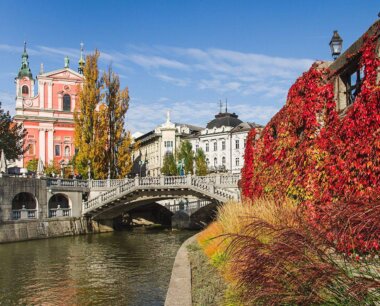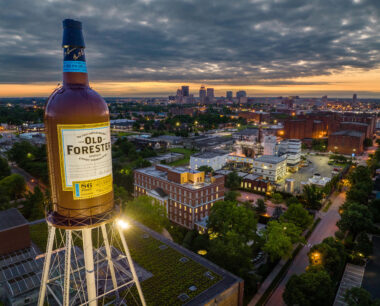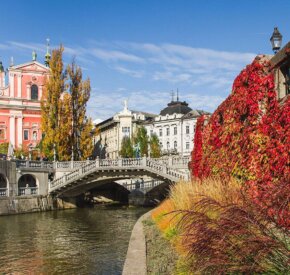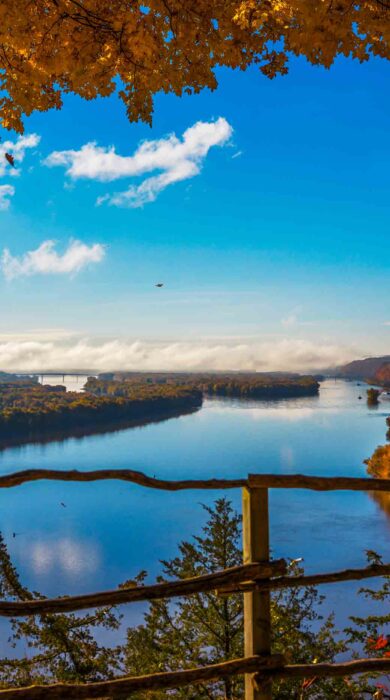
5 things you didn’t know you could do in Iowa
World-class architecture, surprising natural wonders and a rich literary heritage – there’s more than cornfields in flyover country.
A few things typically come to mind when someone mentions Iowa: corn, soybeans and maybe even the Iowa State Fair, where campaigning politicians walk beside prize-winning pigs. But while Iowa is known for its agriculture, there’s so much more to discover in the heart of the Midwest.
From places that inspired American artists, writers and architects to natural areas with deep cultural and geological significance, Iowa is far from a flyover state. Here’s how to make the most of a a trip:
1. Step inside one of America’s most famous paintings

Grant Wood’s “American Gothic” has become one of the most recognisable (and most parodied) paintings of the 20th century. In the piece, a sombre-faced couple stand together – the man holds a pitchfork while the woman frowns into the distance – in front of a stark, white farmhouse.
While the painting itself hangs in the Art Institute of Chicago, the home that inspired it is in rural Iowa. Located in the southeastern town of Eldon, the American Gothic House looks almost the same as when Wood painted it nearly 100 years ago. Today, the home and adjacent visitors centre welcome guests who are curious to take a peek inside a piece of American art history.
2. Explore prehistoric underground caves at Maquoketa Caves State Park
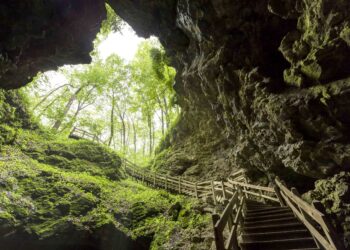
People pass through Iowa expecting to see cornfields, but what about caves? The state has a number of prehistoric underground caves, but the 13-cave system at Maquoketa Caves State Park is one of the most impressive. Here towering bluffs and captivating geologic formations give way to lush hardwood forests ready to be explored via the park’s almost 10km trail system.
While some caves are better suited for serious spelunkers, many of the park’s most popular sites can be explored on foot. The 335m Dancehall Cave is the true show-stopper with a towering entrance, natural bridge and flowing underground stream. This cave is not only the park’s largest, but also its most accessible with a lighted and paved path and a wooden staircase extending to its lower levels.
3. Get lost in a book in a UNESCO City of Literature
There are 53 cities across six continents that have been named UNESCO Cities of Literature for their dedication to promoting cultural diversity and literary richness. One of them is Iowa City.
Known amongst creatives for the prestige of the Iowa Writers’ Workshop at the University of Iowa, Iowa City has a lot to offer for non-academic bookworms as well. Browse for a new read at popular indie shop Prairie Lights Bookstore – and don’t miss the Literary Walk, a series of public art pieces and panels scattered around downtown that celebrate works by writers with Iowa connections.
Then, mark your calendar for the annual Iowa City Book Festival: held each October, it includes a variety of events featuring nationally renowned authors, plus workshops and a book fair.
4. Learn about the area’s Indigenous heritage at Effigy Mounds National Monument

While it offers far-reaching views of the Upper Mississippi River Valley, Effigy Mounds National Monument is more than just a picturesque natural area. Across the nationally protected site, there are more than 200 mounds built by the area’s early Indigenous peoples and at least 20 modern tribes have cultural ties to this land. Many of the mounds are shaped like animals and served as sacred, ceremonial sites.
Today, visitors can hike the hilly riverfront area to experience what remains of the mounds. For those short on time, the 6km Marching Bear Group trail showcases the largest mound group, including ten bear-shaped and three bird-shaped structures.
5. Sleep in the world’s only remaining Frank Lloyd Wright-designed hotel
The Historic Park Inn Hotel in Mason City offers a lesson in Wright’s revered Prairie School style. Opened in 1910, this historic property is the only remaining hotel designed by renowned architect Frank Lloyd Wright in the world. It’s characterised by strong horizontal brick lines, which play against art glass and tilework in earthy tones. Over the years the hotel fell into disrepair, but today, the historic property has been beautifully restored with 27 guest rooms complete with modern amenities.
Architecture buffs won’t want to sleep (no pun intended) on Mason City as a whole either. The Prairie-style movement’s impact on the community is far reaching, particularly in the Rock Crest–Rock Glen Historic District, which is the world’s largest collection of Prairie Style homes in a concentrated area.
